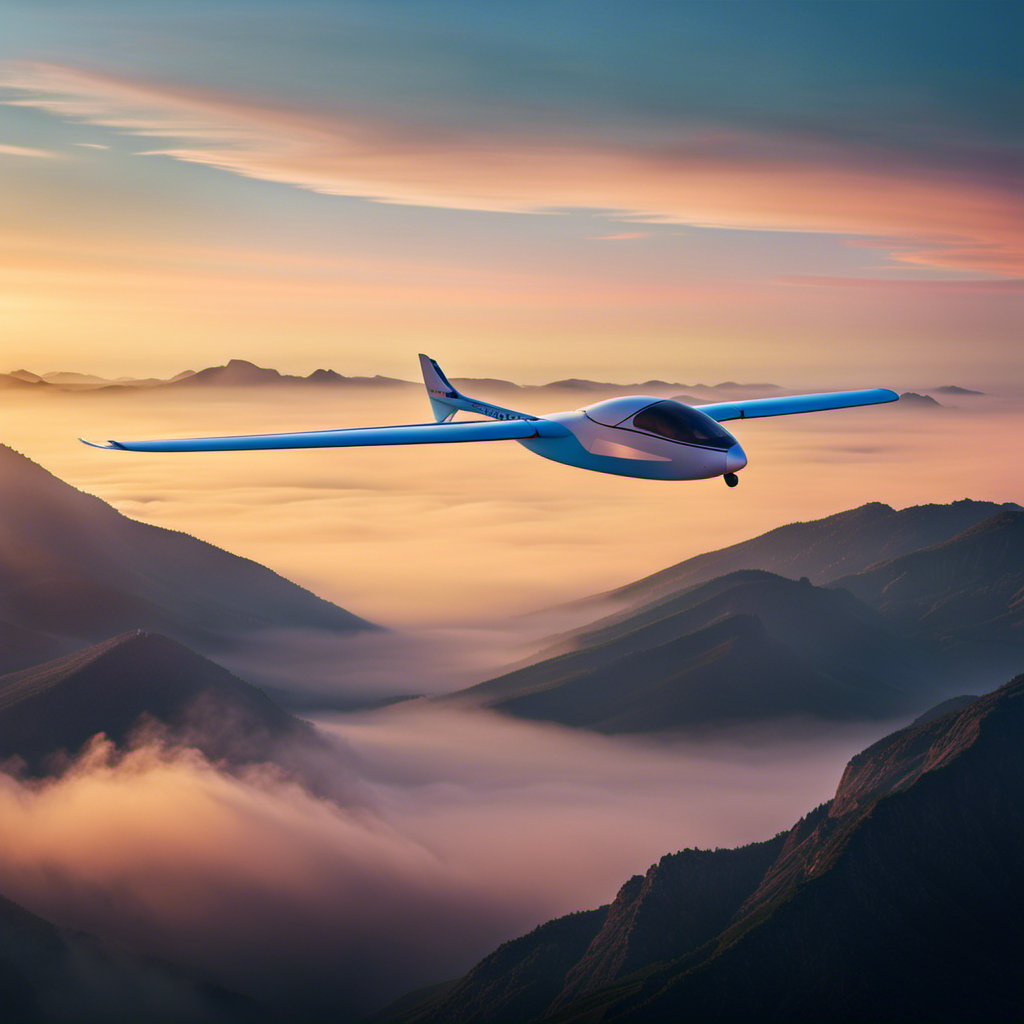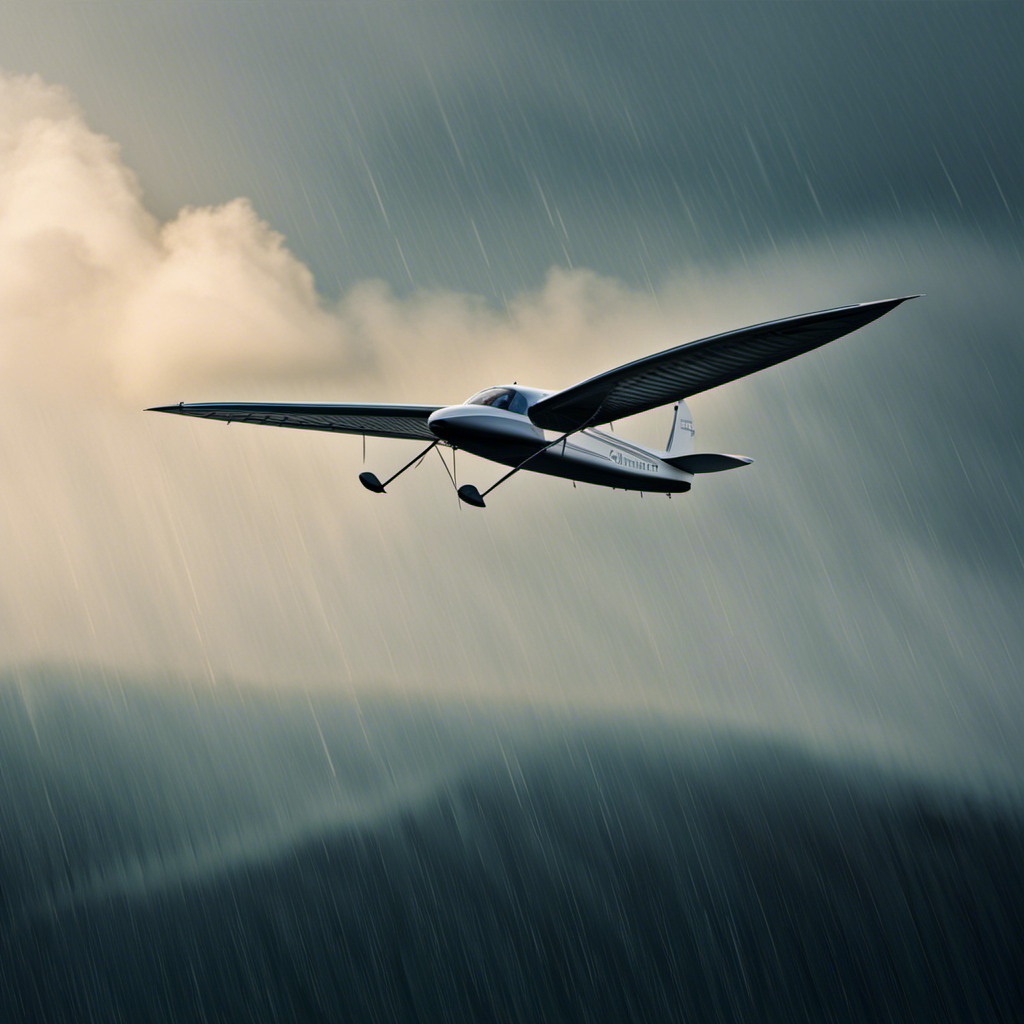Have you ever fantasized about soaring through the skies and feeling the wind beneath your wings? Get ready to soar!
In this article, we will explore the exhilarating world of aviation and delve into the art of soaring. From the rich history of this awe-inspiring sport to the various types of aircraft used, we will uncover the techniques and skills required to master the skies.
So buckle up and prepare to be captivated by the thrill of soaring!
Key Takeaways
- Soaring in aviation involves a training and certification process that equips individuals with necessary skills and knowledge in areas such as aerodynamics, meteorology, navigation, and emergency procedures.
- The thrill and experience of soaring include the exhilaration of flying in a glider, a sense of freedom and serenity, reliance on wind and thermals, and the adrenaline rush from catching strong thermals.
- Soaring has environmental benefits, such as reducing emissions by relying on wind, operating silently to reduce noise pollution, and having zero fuel consumption and emissions, thus contributing to sustainability.
- Challenges and future considerations in soaring include reliance on weather conditions, availability of suitable launch sites, urban development encroaching on open spaces, pilot training and retention, attracting and educating new enthusiasts, and promoting the benefits of soaring.
The History of Soaring
You might be interested to know that the history of soaring began in the late 19th century.
It was during this time that pioneers like Otto Lilienthal and Octave Chanute made significant contributions to the development of gliding.
Lilienthal, often referred to as the ‘father of aviation,’ conducted extensive research and experimentation with various wing designs and flight techniques.
His work laid the foundation for future advancements in soaring.
Chanute, an engineer and aviation enthusiast, furthered Lilienthal’s efforts by conducting detailed studies on aerodynamics and glider design.
Their combined knowledge and insights paved the way for the principles of soaring that we will explore next.
From understanding the importance of lift and drag to mastering the art of controlling a glider, these principles form the backbone of successful soaring.
The Principles of Soaring
The principles of soaring are based on utilizing updrafts and thermals to maintain altitude and extend flight time. By understanding the atmospheric conditions and the way air moves, you can manipulate your aircraft to stay aloft for longer periods.
Updrafts are columns of rising air caused by the heating of the Earth’s surface. These can be found near mountains, hills, or even over large fields.
Thermals, on the other hand, are localized areas of warm air that rise from the ground. They can be generated by the sun heating the Earth’s surface unevenly.
To take advantage of these natural phenomena, pilots carefully study the weather patterns and use techniques such as circling within thermals or ridge soaring along the edges of hills and mountains.
By mastering these principles, you can optimize your flight and stay airborne for extended periods.
Now let’s delve into the different types of soaring aircraft.
Different Types of Soaring Aircraft
To fully enjoy the sport, it’s important to understand the different types of aircraft used in soaring.
There are several types of soaring aircraft, each designed for specific purposes and conditions. The most common type is the glider, which is a lightweight, engineless aircraft that relies on the natural forces of lift to stay aloft. Gliders come in various shapes and sizes, from small, single-seat aircraft to larger, multi-seat ones.
Another type of soaring aircraft is the motor glider, which combines the benefits of a glider and a powered aircraft. Motor gliders have engines that can be used for takeoff and climbing, but they can also glide like traditional gliders.
Understanding the different types of soaring aircraft will help you make informed decisions when choosing the right aircraft for your soaring adventures.
Now that you know about the different types of aircraft, let’s explore some techniques for soaring.
Techniques for Soaring
Now that we’ve covered the different types of aircraft, let’s dive into some techniques for getting the most out of your soaring experience.
Soaring is not just about sitting back and enjoying the ride; it requires skill and strategy to maximize your flight time and reach new heights. Here are four techniques to help you soar like a pro:
-
Find the right thermals: Thermals are pockets of warm air that can lift your glider higher. Look for signs like cumulus clouds or birds circling in the sky, indicating the presence of thermals.
-
Use ridge lift: When wind blows against a hill or mountain, it creates an upward force known as ridge lift. Utilize this natural phenomenon by flying close to ridges or cliffs to gain altitude.
-
Practice energy management: Soaring is all about conserving and efficiently using your glider’s energy. Learn to control your speed, adjust your glide ratio, and make smooth turns to maintain optimal energy levels throughout the flight.
-
Learn from experienced pilots: Join a soaring club or take lessons from experienced pilots to learn valuable tips and techniques for soaring. Their knowledge and expertise can greatly enhance your skills and confidence in the air.
By employing these techniques, you can enhance your soaring experience and take your skills to new heights.
Now, let’s explore the exciting world of soaring competitions and records.
Soaring Competitions and Records
Joining a soaring club or taking lessons from experienced pilots can provide valuable insights and techniques for enhancing your skills and confidence in the air.
Once you have gained some experience in soaring, you may consider participating in soaring competitions or attempting to break records. Soaring competitions are organized events where pilots compete against each other in various tasks, such as distance, speed, and duration. These competitions are a great opportunity to test your skills and compete against other pilots who share the same passion for soaring.
Additionally, attempting to break records in soaring can be a thrilling challenge. Whether it is achieving the longest distance or the highest altitude, setting records can push you to new heights and showcase your capabilities as a pilot.
Safety considerations in soaring are crucial to ensure a successful and incident-free flight.
Safety Considerations in Soaring
When flying, it’s important to always be aware of potential hazards and maintain a vigilant attitude towards safety. Soaring, like any other form of aviation, comes with its own set of safety considerations. Here are four important factors to keep in mind:
-
Weather conditions: Stay updated on weather forecasts and be cautious of sudden changes in wind direction or intensity. Strong winds can affect the handling of the glider and pose a risk to your safety.
-
Terrain and obstructions: Familiarize yourself with the soaring area and be aware of any potential obstructions such as power lines, tall trees, or hills that could interfere with your flight path.
-
Emergency procedures: Understand the emergency procedures for your glider and be prepared to execute them if necessary. This includes knowing how to handle a forced landing or a sudden loss of altitude.
-
Communication: Maintain effective communication with other pilots and air traffic control, if applicable. This ensures that everyone is aware of each other’s location and intentions, reducing the chance of mid-air collisions.
By adhering to these safety considerations, you can enjoy the thrill of soaring while minimizing the risks involved.
Now, let’s delve into the training and certification required for soaring.
Training and Certification for Soaring
To become a certified glider pilot, you’ll need to complete a series of training courses and pass both written and practical exams.
The training process is designed to equip you with the necessary skills and knowledge to safely operate a glider aircraft. The courses cover a wide range of topics, including aerodynamics, meteorology, navigation, and emergency procedures.
The written exams test your understanding of these subjects, while the practical exams assess your ability to apply what you’ve learned in real-world scenarios.
Once you’ve successfully completed the training and passed the exams, you’ll receive your certification, allowing you to legally fly glider aircraft. It’s a rigorous process, but the rewards are well worth it.
Soaring through the sky, feeling the wind beneath your wings, is an experience like no other.
The Thrill of Soaring
Experiencing the exhilaration of flying through the air in a glider is like nothing else. As you soar high above the ground, you feel a sense of freedom and serenity that can’t be replicated by any other form of aviation.
The lack of an engine means that you are completely at the mercy of the wind, relying on its currents and thermals to keep you aloft. It’s a thrilling experience to navigate these invisible forces, using your skill and knowledge to stay airborne. The rush of adrenaline as you catch a strong thermal and climb higher and higher is truly addictive.
But soaring isn’t just about the thrill; it also offers significant environmental benefits.
Environmental Benefits of Soaring
The lack of an engine in a glider means you’re relying solely on the wind, which has significant environmental benefits. Soaring, or gliding, is an aviation activity that harnesses the power of the wind to keep a glider aloft without the need for an engine. This reliance on natural air currents brings several environmental advantages. Firstly, soaring produces zero emissions, making it an eco-friendly form of aviation. Additionally, gliders operate silently, reducing noise pollution in the surrounding areas. Moreover, the absence of an engine means that gliders do not consume any fuel, resulting in a lower carbon footprint compared to powered aircraft. The environmental benefits of soaring are summarized in the table below:
| Environmental Benefits of Soaring |
|---|
| Zero emissions |
| Reduced noise pollution |
| Lower carbon footprint |
These advantages make soaring an attractive option for those seeking a sustainable and environmentally conscious form of aviation. However, despite these benefits, there are still challenges and future considerations for the sport of soaring.
Challenges and Future of Soaring
If you want to continue gliding, you’ll need to be aware of the challenges and future considerations for the sport. Soaring, while exhilarating and environmentally friendly, is not without its difficulties.
One of the main challenges is the reliance on weather conditions. Gliders depend on thermal currents and wind patterns to stay aloft, so pilots must constantly monitor meteorological reports to determine the best times and locations for soaring.
Another consideration is the availability of suitable launch sites. As urban development continues to encroach on open spaces, finding areas with adequate space for takeoff and landing becomes increasingly difficult.
Additionally, the soaring community must address the issue of pilot training and retention. As experienced pilots retire, it is crucial to attract and educate new enthusiasts to ensure the future of the sport.
Frequently Asked Questions
What are the specific safety regulations and guidelines for soaring aircraft?
Safety regulations and guidelines for soaring aircraft include adherence to air traffic control procedures, compliance with weight and balance limits, regular inspections, proper equipment maintenance, and adherence to flight rules and restrictions.
How long does it take to obtain a certification for soaring?
Obtaining a certification for soaring can take anywhere from 6 months to 1 year, depending on your dedication and the training program. It requires a combination of classroom instruction, flight training, and passing a written and practical exam.
Are there any medical requirements for individuals interested in participating in soaring competitions?
To participate in soaring competitions, you must meet certain medical requirements. These typically include having a valid medical certificate, which is issued by an aviation medical examiner after a thorough examination of your physical and mental health.
What are the most common environmental challenges faced by pilots during soaring flights?
During soaring flights, pilots often face environmental challenges akin to navigating a treacherous maze. These include turbulent air currents, unpredictable weather patterns, and thermal variations, all of which demand great skill and adaptability to overcome.
How can beginners get started in the sport of soaring?
To get started in soaring, beginners should join a local glider club and take lessons from a certified flight instructor. They will learn about the principles of gliding, how to control the aircraft, and gain practical experience through solo flights.
Conclusion
In conclusion, soaring in aviation is like riding the wind’s mighty waves, effortlessly gliding through the sky. It is a thrilling and environmentally-friendly way to experience the freedom of flight.
With a rich history, diverse aircraft options, and exciting competitions, soaring offers a unique blend of skill and adventure.
Despite the challenges and uncertainties that lie ahead, the future of soaring holds promise, as more enthusiasts are drawn to this awe-inspiring form of aviation.
So spread your wings and let the wind carry you towards new heights in the world of soaring.
With a heart that soars as high as the skies, Aria, affectionately known as “Skylark,” is the driving force behind Soaring Skyways. Her journey into the gliding world began as a young dreamer gazing up at the soaring birds, yearning to experience the weightlessness and freedom they embodied. With years of experience both in the cockpit and behind the scenes, Aria’s commitment to the gliding community is unwavering.










